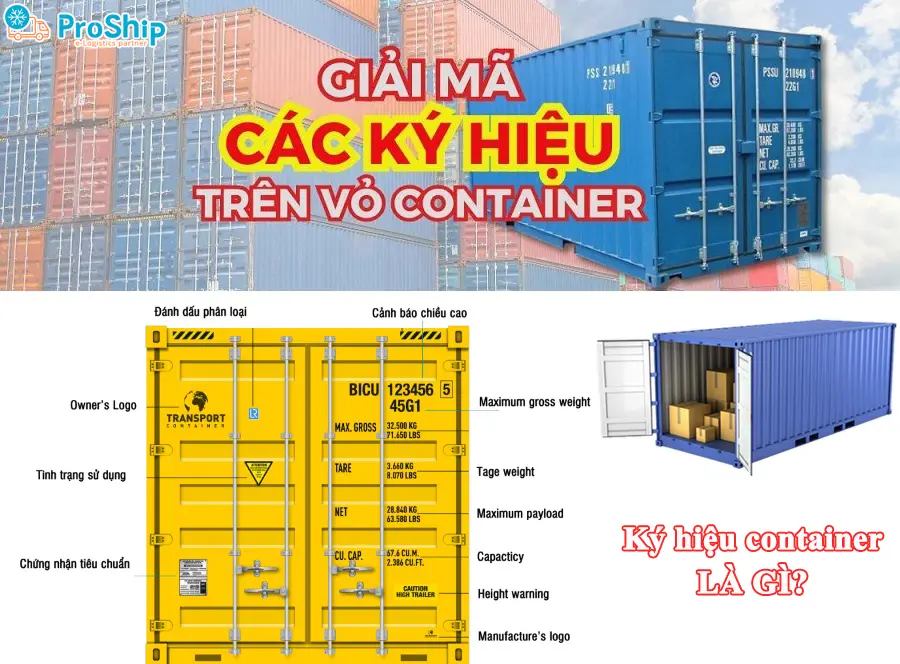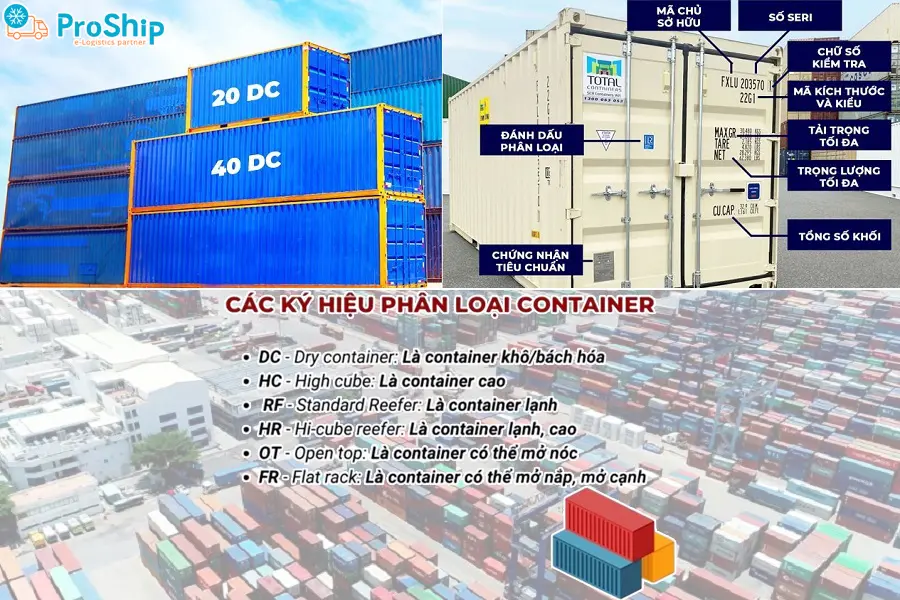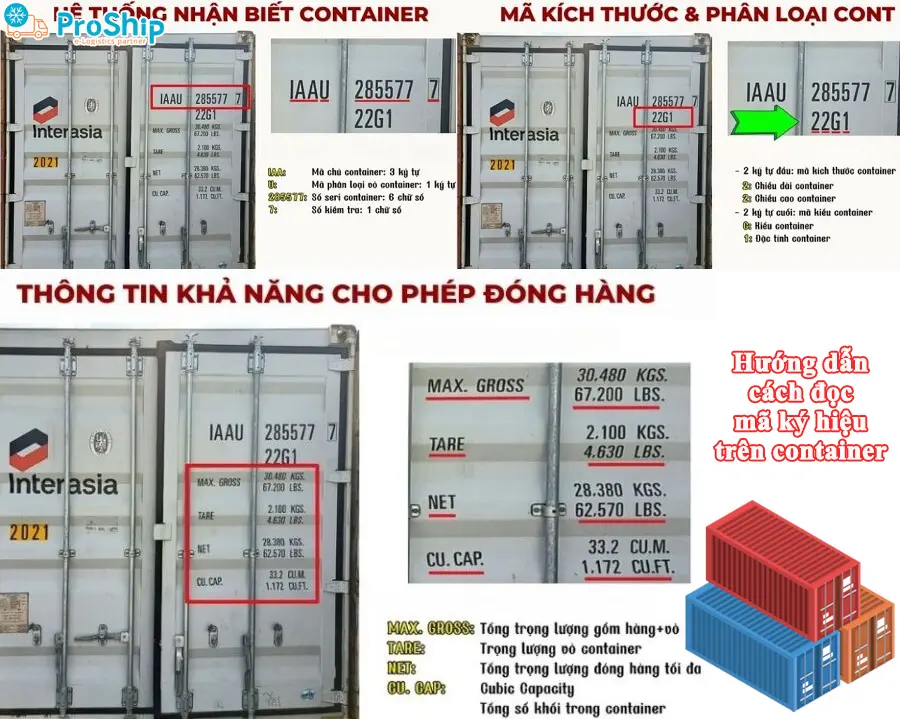Bạn có bao giờ thắc mắc các ký hiệu như “40’HC”, “20’DC”, “OT”, “RE” trên Container nghĩa là gì? Đây là ký hiệu tiêu chuẩn quốc tế (ISO 6346) dùng để phân biệt loại, kích thước và tính chất Container như Container thường, Container cao (“High Cube”), Container lạnh (“Reefer”) hay Container mở nóc (“Open Top”). Hãy cùng Proship.vn tìm hiểu cách đọc ký hiệu các loại Container đầy đủ để dễ nhận biết và sử dụng đúng trong xuất nhập khẩu. Cùng khám phá hiểu rõ nhé!
>>Xem thêm: chuyển nhà bằng Container Bắc Nam – dịch vụ kéo Container
Ký hiệu các loại Container là gì?
Vận tải Container là phương pháp vận chuyển mang tính chất toàn cầu. Nó thường được dùng trong các giao dịch thương mại quốc tế, vì vậy cần có những thống nhất về kí hiệu. Theo đó, kí hiệu Container là những kí tự, thông số với chức năng phân biệt thành các dạng Container khác nhau.

Ký hiệu các loại Container và ý nghĩa của các ký hiệu
Tổng hợp các loại Container và ký hiệu CẦN BIẾT:
Kí hiệu Container theo kích thước
Theo kích thước, ký hiệu Container được thể hiện:
- Chiều dài: Có ba loại độ dài tiêu chuẩn của Container là 20 feet (6.1m), 40 feet (12.2 m), 45 feet (13.7m);
- Chiều cao chủ yếu dùng 2 loại: thường và cao. Loại Container thường cao 8 feet 6 inch (8’6”), loại cao có chiều cao 9 feet 6 inch (9’6”);
- Chiều rộng bên ngoài (20’DC, 40’DC, 40’HC): 8 feet (2,438m).
Ký hiệu phân biệt các loại Container
- HC (High cube):
Chuyên để đóng hàng có kích cỡ và khối lượng lớn. Loại này phù hợp với làm văn phòng, nhà ở Container.
- DC – Dry Container:
DC là viết tắt của “Dry Container” tức là Container khô là loại cơ bản nhất, viết tắt là 20’DC hoặc 40’DC. Loại này để đóng gói hàng khô, nặng, thể tích nhỏ như gạo, bột, xi măng, sắt, thép,…
- RE (Reefer):
Container thiết kế chuyên dành cho kho lạnh, xe đông lạnh. Container lạnh chia làm 2 loại là: nhôm và sắt. Lớp bên trong Container được làm bằng inox để chống chịu nhiệt độ lạnh khắc nghiệt.
- HR (Hi – cube reefer):
Loại này cũng là dạng cont lạnh nhưng cao để chuyên chở hàng có sức chứa lớn.
- FR (Flat rack):
Là Container không vách, không mái, chỉ có sàn, chuyên để vận chuyển các loại hàng hóa nặng. Container loại này có vách hai đầu trước sau, có thể cố định, gập xuống hoặc tháo rời.
- OT (Open top):
Là loại cont mở nóc, có thể đóng hàng và rút hàng qua nóc. Sau đó nóc Container sẽ được phủ bạt để che chắn mưa. Loại này chuyên để chở máy móc, thiết bị.
- Kẹp chì (Seal Container):
Là khóa niêm phong Container, sử dụng để niêm phong Container trước khi xuất hàng để đảm bảo hàng bên trong đủ số lượng, hạn chế ảnh hưởng chất lượng.
Trong ký hiệu các loại Container, loại kẹp chì này còn gồm 1 dãy serial gồm 6 chữ số. Mỗi Container niêm phong 1 số chì duy nhất và sẽ được khai hải quan qua các kí hiệu: P/L, B/L, C/O.

Ký hiệu trên vỏ thùng Container cơ bản
Ký hiệu trên Container có rất nhiều ký hiệu, mã hiệu,…Hệ thống nhận biết gồm:
* Mã chủ sở hữu (owner code).
* Ký hiệu loại thiết bị (equipment category identifier/product group code):
- U: Container chở hàng (freight Container);
- J: Thiết bị có thể tháo rời (detachable freight Container-related equipment);
- Z: Đầu kéo (trailer) hoặc mooc (chassis).
* Số sê-ri (serial number/registration number): Ví dụ 001234, 002334.
* Chữ số kiểm tra (check digit).
* Mã kích thước (size code): Gồm 2 ký tự là chữ cái hoặc chữ số, trong đó kí tự đầu biểu thị chiều dài Container, kí tự thứ hai là chiều cao Container.
* Mã loại (Type code): Gồm 2 ký tự, kí tự đầu là loại Container như: G – General R-Refrigerate; U – Open top. Ký tự thứ 2 là đặc tính chính của Container.
Các ký hiệu khai thác (operational markings)
Dấu hiệu trong khai thác gồm BẮT BUỘC và KHÔNG BẮT BUỘC:
- Dấu hiệu bắt buộc: Tải trọng cont, cảnh báo nguy hiểm điện; cont cao.
- Dấu hiệu không bắt buộc: Khối lượng hữu ích lớn nhất (max net mass), mã quốc gia (country code).
Hướng dẫn cách đọc mã ký hiệu trên Container
Proship hướng dẫn cách đọc các loại Container và ký hiệu, mã ký hiệu chuẩn nhất:
Hệ thống nhận biết Container
Hệ thống nhận biết Container gồm:
3 ký tự đầu: Là mã của chủ Container đã được đăng ký với Cơ quan đăng kiểm quốc tế hoặc đăng ký trực tiếp với Cục Container quốc tế – BIC, chủ Container không nhất thiết phải là hãng tàu.
Ký tự chữ cuối cùng: Để phân loại vỏ Container. Ý nghĩa một số ký tự cuối là:
- U: Container chở hàng;
- J: thiết bị có thể tháo rời của Container chở hàng;
- Z: đầu kéo hoặc rơ mooc.
6 ký tự số: Là số Container do chủ Container quản lý, đặt ra với quy ước không được trùng với các cont khác. Nếu số cont không đủ 6 chữ số sẽ thêm các số 0 phía trước để đủ 6 số. Ví dụ: Số cont là 1234 thì số cont đầy đủ là 001234.
Số được in và đóng khung trên cont: Là số kiểm tra với mục đích kiểm tra tính chính xác của số cont để tránh các trường hợp số cont bị trùng lặp.
Mã kích thước và phân loại
Mã kích thước: 2 ký tự đầu có thể là số hoặc chữ:
- Ký tự thứ nhất biểu thị chiều dài Container: số 2 tương ứng với cont 20 feet, số 4 là 40 feet, và đặc biệt với cont 45 feet sẽ được ký hiệu là chữ L;
- Ký tự thứ 2 biểu thị chiều cao của Container, quy ước: số 0 = 8 ft; 2 = 8,6 ft, 5 = 9,6ft.
Mã kiểu: 2 ký tự cuối gồm:
Ký tự thứ nhất cho biết kiểu Container thường gặp:
- G: để thể hiện là Container hàng bách hoá, cont thường (General Container);
- R: là cont lạnh (Refrigerate cont);
- U: là cont mở mái (Open top);
- T: là cont bồn (Tank Container);
- P: là cont phản (Platform Container).
Ký tự số cuối cùng trong dãy 4 ký tự được hiểu:
- Số 0: Là cont đó có thể mở 1 đầu hoặc 2 đầu (có thể mở được 1 hoặc 2 cửa);
- Số 1: Là cont đó sẽ có cửa thông gió ở bên trên;
- Chữ P: Biểu hiện cho loại cont chứa cả 2 loại trên.

Các ký hiệu khai thác
Các ký hiệu khai thác gồm:
1. Thông tin khả năng đóng hàng cho phép của vỏ Container
- MGW (Max Gross Weight): Là tổng trọng lượng tối đa cho phép (tổng trọng lượng của nguyên Container gồm cả vỏ và tất cả hàng hóa trong đó), được đo lường bằng 2 đơn vị theo chuẩn ISO 6346 là Kg và Lb (1kg sẽ gần 2,2 Lb);
- Tare: Là trọng lượng của vỏ cont;
- Net: Là tổng lượng vật chất gồm hàng hóa, vật liệu chèn lót, lashing,…(Max = Tare + Net);
- Cu.Cap (Cubic Capacity): Là tổng số khối trong cont, được tính bằng đơn vị mét khối (m3) và feet khối (ft3). Chuyển đổi theo công thức: m3 = ft3/35,315.
2. Bảng CSC (Container Safety Convention)
Trong bảng này gồm:
- Niêm phong hải quan cho phép Container vận chuyển và Chứng nhận an toàn theo công ước CSC,…;
- Bảng CSC như là một tấm hộ chiếu cho phép Container được di chuyển khắp nơi qua các nước.
3. Logo hoặc tên chủ sở hữu Container.
4. Logo đơn vị kiểm định chất lượng Container (không bắt buộc phải có).
5. Các thông tin cảnh báo trên vỏ Container.
Câu hỏi thường gặp
1. Ký hiệu “40’HC” có nghĩa là gì?
“40” là độ dài Container (40 feet), “HC” là “High Cube” – loại cao hơn Container thường, giúp chứa hàng có chiều cao lớn hơn.
2. Container “RE” (Reefer) và “DC” (Dry Container) khác nhau như thế nào?
“DC” là Container khô, dùng chở hàng không cần điều chỉnh nhiệt độ. “RE” / “R” là Container lạnh, có hệ thống làm lạnh để bảo quản hàng hóa cần nhiệt độ ổn định.
3. Mã chủ sở hữu (owner code) trong ký hiệu Container là gì?
Là mã gồm 3 ký tự được đăng ký quốc tế, xác định chủ Container. Ví dụ “MSKU”, “MAEU”…
4. Check digit (chữ số kiểm tra) trong mã Container có tác dụng gì?
Là số dùng để xác thực rằng mã Container đúng, tránh nhầm lẫn hoặc trùng lặp; thường là 1 chữ số cuối cùng sau số sê-ri.
5. Các ký hiệu khai thác trên vỏ Container gồm những gì?
Bao gồm khối lượng tối đa được phép, trọng lượng vỏ, cảnh báo nguy hiểm, cảnh báo chiều cao, ký hiệu kiểm định CSC, chữ ký giấy, tên chủ sở hữu, và các cảnh báo vận chuyển quốc tế.
Trên đây là tổng hợp thông tin ký hiệu các loại Container, gồm ký hiệu Container thông thường và ký hiệu trên Container dùng trong KBHQ,…Việc nắm rõ các loại Container và ký hiệu như Proship chia sẻ sẽ giúp Doanh nghiệp, Chủ hàng hiểu được ý nghĩa các chữ viết tắt thể hiện trên Container là gì nhằm hỗ trợ cho quá trình XNK.
…Và nếu có bất cứ thắc mắc liên quan tới vận tải hàng hóa bằng Container đi Nội địa hoặc Quốc tế, liên hệ ngay 0909 344 247.
>>Xem thêm:

